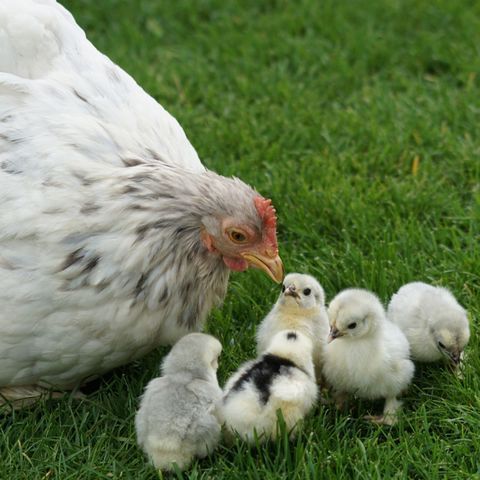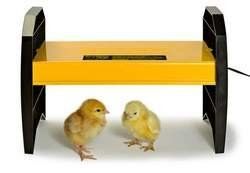Guide to Rearing Chicks
0
Guide to Rearing Chicks
Using a broody hen to hatch fertile eggs
Most broody hens take to motherhood very well and will take care of their chicks. Their nest should be in a dry place and have plenty of nesting material - straw and hay are ideal. Don't disturb your hen while the chicks are hatching. The hen will provide all the heat your chicks need as long as they can all fit under her. You should ensure that food and water are freely available (see more about food and water for chicks further down this page). In rare cases, broody hens can turn aggressive towards the chicks or abandon them. A brooder should be prepared just in case.
Introducing newly hatched chicks to a broody hen
When a hen is broody and has been sitting on eggs for several weeks, it is possible to introduce day old chicks for her to rear. The chicks should be as young as possible, ideally no more than a few days old. At night, carefully remove the eggs from under then hen and replace them with the chicks. Don't let the hen see the chicks before they are placed underneath her. Sometimes the hen can reject the chicks. A brooder should be available in case this happens.

Rearing in a brooder
If you're buying day-old chicks and transporting them home, you will need a small box so the chicks are huddled together with plenty of insulation in the bottom - scrunched up kitchen roll and hay are ideal. Durham Hens will provide a box if you are buying them from us. Place the chicks in a pre-heated brooder as soon as you get them home. If you're hatching chicks in an incubator, don't be tempted to open the incubator more than necessary as this will affect the temperature and humidity for any chicks that are still hatching. Leave the chicks in the incubator until they are dry and fluffy.
The brooder
The most important part of the brooder is the heat source. Newly hatched chicks need to be kept at 35 degrees at first and this is reduced slowly over approximately six weeks. Keeping chicks at the correct temperature is the most important aspect of rearing chicks successfully. If chicks are too hot or cold they will cheep loudly. Check how they are behaving. If they are too hot, they will move away from the heat source and be spread out around the brooder. When it's too cold, they will be huddled together under the heat source. A normal 60w bulb or a red 60w normal bulb do not provide enough heat. Please be wary of cheap brooders that use these for sale on places like Ebay.
A heat lamp or electric hen can be used. Heat lamps should be hung out of reach of the chicks but not too high from the ground. Test the temperature below the brooder at ground level where the chicks will be. It should be about 35 degrees.
There are different types of bulbs for heat lamps. Ceramic bulbs are more economical to use and last longer than infra-red bulbs but they are more expensive to buy. They give off heat but no light. Infra-red bulbs emit both heat and light. In winter, there is not enough daylight for chicks so extra light should be provided. They need about 12 hours of light per day so they can eat enough to grow properly. They will not eat or drink in the dark.
The heat lamp holder will get hot so do not touch it when it is switched on. Also, make sure it is well-secured because fires have been known to start when they have fallen onto bedding.
Electric hens use less power than heat lamps and are safer. The heated plate warms to body temperature and it keeps the chicks warm through contact. It will not burn them if they touch it. The height is adjustable and it should be on the lowest setting for newly hatched chicks. If it is too high, the chicks will get cold.
Do not be tempted to use an ordinary light bulb as a heat source. They do not give off sufficient heat for brooders. Place the brooder away from draughts, radiators, direct sunlight and windows. Bear in mind that the background temperature will affect the temperature inside the brooder. If your central heating goes off at night, is the brooder still warm enough? If you have the brooder in an outdoor building, does it drop too cold at night?
The floor of the brooder should be covered with a non-slip material. We use corrugated cardboard but newspaper covered with sheets of kitchen rolls is fine. If the chicks are placed on a slippery surface, their risk of suffering from splayed leg increases dramatically. As the chicks grow, wood shavings can be used as bedding.
At Durham Hens, we have found that indoor pet cages with Brinsea Eco Glow heaters inside are ideal brooders and use them for our newly hatched chicks.
The brooder should contain a feeder and drinker suitable for chicks. The drinker should have a very narrow lip to prevent drowning. If a wider drinker is used, place pebbles into the water so the chicks cannot fall in.
Depending on the season, chicks should not require extra heat by 6-8 weeks of age and they go outdoors at this age. Use plenty of clean, dry bedding to help them stay warm at night.

Food and drink for chicks and growers
Chick starter mash or crumb is ideal for newly hatched chicks. By the third week, the chicks food consumption will increase substantially so make sure you have plenty of food for them.Food should be available at all times to make sure the chicks eat plenty. They will not overeat.Chicks need chick flint grit to help with their digestion. This can be put into a small container so you can see when they need more.
Chick health
Growers should be wormed regularly once they are outdoors, from approximately 8-10 weeks old. We use Verm-X Poultry Liquid. Chicks and growers can be affected by mites and lice, so a dust bath with Smite powder should be available for them to clean themselves.
Chicks are prone to coccidiosis, a condition caused by internal parasites. Medicated chick crumb contains a coccidiostat to help control this condition. If an unmedicated feed is used, Coxoid can be added to the water instead. Coccidiosis will kill growers if left untreated so please be aware of it and take precautions against it. Signs of coccidiosis include chicks sitting hunched, going light (losing weight) and sometimes blood in the droppings. If you suspect your chicks have coccidiosis, clean your housing with Bi-oo-cyst. The eggs that spread the parasite (oocysts) are very resilient and Bi-oo-cyst is one of the few disinfectants that will kill them.
Mareks disease is a viral infection that affects young birds. It causes tumours to grow internally. The common signs are paralysed wings and/or legs or blindness. The virus is contracted at a young age but symptoms tend to appear between 16 to 30 weeks of age. Mareks disease cannot be treated and most affected birds will die.
Stargazing, twisted neck or wry neck can be a sign of Mareks disease, occasionally it can be caused by a head injury but most often it is due to a vitamin deficiency (Vitamin E). Adding a supplement to the diet should help. Using a top quality brand of chick food can reduce the occurrence of this problem.
Adding young hens to your flock
When you introduce young birds to your flock, they have to sort out the pecking order. Expect a few pecks and scuffles. We recommend adding them when they are fully grown or at least 18 weeks old age. There is more information on this in our Guide to Keeping Chickens.
Address
Durham Hens LimitedVine HouseTow LawCounty DurhamDL13 4BNTel: 01388 731131Mob: 07763929686
Opening Hours
Friday 10am-4pm
Saturday 10am-4pm
Easter Weekend
Good Friday 10am-4pm
Saturday 10am-4pm
Easter Sunday Closed
Easter Monday Click & Collect
only
Choose your hens and browse
in our shop!
Click & Collect
Monday 10am-4pm
Tuesday 10am-4pm
Wednesday Closed
Thursday 10am-4pm
Friday 10am-4pm
Saturday 10am-4pm
Sunday Closed
Terms and Conditions
Copyright Durham Hens Limited 2023
